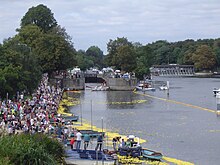Duck racing

A duck race is a folk festival-like event in which several thousand rubber ducks swim in competition on mostly inner-city flowing water . Usually organized for fundraising purposes, these ducks are numbered and thus enable the participants to “adopt” a duck for a small amount of money and to win cash or material prizes if the duck wins or is well placed.
The proceeds from the purchase of the ducks will go to the work of the non-profit organization . From a legal point of view, a duck race in Germany is a lottery .
The first duck race took place in Ottawa in 1987 . In the 1990s, duck races spread through the industrialized world. They are considered an original form of fundraising, in which the duck also acts as a popular figure for the organizer. Compared to other forms of tombola, however, a duck race entails considerable organizational effort. In some cases, organizers already fear risks because duck races would take place too often. They are also controversial for environmental reasons, since during duck races thousands of plastic objects are used in a body of water, which after the race u. U. cannot be completely removed from this again.
The number of ducks used in such races varies, with the organizers giving 3,000 ducks as an average. The world's largest duck race to date was the Great British Duck Race on August 31, 2008 on the Thames in London with 250,000 blue rubber ducks taking part. The organizers exceeded their previous year's record of 165,000 yellow ducks. Germany's largest duck race took place in Cologne in 2001 with 50,000 ducks on the Fühlinger See . The race in the Trier - Saarbrücken - Schweich area was one of 365 projects that received an award from the Germany - Land of Ideas initiative .
In 2008 at least 51 duck races took place in Germany. The number of viewers is usually between a few hundred and 80,000. The ducks themselves are increasingly becoming special constructions. A racing duck is characterized among other things by a very flat bottom and a small metal weight for stabilization. In addition, they do not have a squeak valve. These are now not only available consecutively numbered, but can also be rented in large numbers. In the Great British Duck Race, the organizers have been using unusual blue ducks instead of the traditional yellow ones since 2008, as there are repeated attempts at fraud, in which spectators let their private ducks with them in a good position in the water.
literature
- Lotte Larsen Meyer: Rubber Ducks and Their Significance in Contemporary American Culture . In: The Journal of American Culture . Volume 29, Issue 1, 2008, pp. 14-23.
Web links
Individual evidence
- ↑ a b Renate Schüßlbauer: Duck Race - Top or Flop? Workshop at the German Fundraising Congress 2003 as pdf ( page no longer available , search in web archives ) Info: The link was automatically marked as defective. Please check the link according to the instructions and then remove this notice.
- ↑ Fundracing.de: Know How duck racing
- ↑ a b Fundraisinghelp.com: "Fundraising Rubber Duck Race"
- ↑ a b c World Record Racers Are Blue
- ↑ 16 before: "Duck race for 'nest warmth'" ( Memento of the original from July 7, 2010 in the Internet Archive ) Info: The archive link was inserted automatically and has not yet been checked. Please check the original and archive link according to the instructions and then remove this notice.
- ↑ Duck race dates
- ^ Marita Haibach: Fundraising Handbook . Campus Verlag, 2006, ISBN 3593379341 , p. 305.
